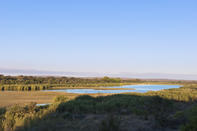Flat Plains of the Lowveld

As Louis Trigard readied for the journey into the Lowveld bush, the first problem was getting their cumbersome ox-wagons down the mountains. Unfortunately, Trigard chose to descend a particularly difficult part of the escarpment and it took the trekkers more than two months to manhandle their wagons down the tortuous route. When they finally arrived on the flat plains of the Lowveld, disease began stalking the party. Malaria-carrying mosquitoes mercilessly ravaged the humans, while nagana took a heavy toll on the oxen and other livestock. It soon became a race against time as the Boer wagons rattled across the treacherous 350 kilometres to the coast.
Against all odds, Trigard finally staggered into Lourenço Marques in April 1838. The greeting from the Portuguese commander was enthusiastic, but the journey had taken its toll. Within a short time of their arrival, most of the party went down with malaria and 27 of them died, including Louis Trigard and his wife. The 26 survivors were taken by ship to Durban, where they related their woeful tale to the other trekkers. It seemed that the fever belt was a no-go area for the fragile man.
A Bellicose Interruption
But then, just when things were getting going, the Second Anglo-Boer War broke out. Also known as the South African War, the conflict was largely instigated by the British, who thought that the conflict would be a short, sharp affair in which their army would sweep aside the backward Boers and usher in a glorious era of imperial rule over most of the sub-continent.
But it was not to be. The war lasted for 3 gruelling years and, after several early British victories, it quickly degenerated into a ‘war of attrition’; a series of skirmishes and raids that proved impossible to stop – not unlike the present-day conflicts in Iraq or Afghanistan. The problem, for the British, was that the enemy refused to mount a massed force that could be defeated in a single battle. Instead, the rebarbative Boers formed themselves into small fighting units, which harried the British troops and then melted away – a model that came to be known as a ‘guerrilla war’.
Understandably, the issue of the game reserves paled into insignificance and the early wardens of the Sabi Game Reserve were regularly released from their duties in order to contribute to the war effort. But even after the British took control of Pretoria, causing Paul Kruger and his cabinet to flee, the war continued to drag on.
Mighty Queen Victoria
Eventually, the British resorted to a ‘scorched earth’ policy, in which the imperial forces burnt all the Boer farmlands in an attempt to starve out the Boer commandos. They also incarcerated thousands of women, children and black farm workers in concentration camps, where disease and malnutrition took an appalling toll. This drastic action finally brought the festering guerrilla war to a bitter and inconclusive close in 1902, when the Boers reluctantly sued for peace. By this time, however, the mighty Queen Victoria was dead and the British Empire was entering its period of terminal decline. Kruger also died two years later (in Clarens, Switzerland) while still in exile.
Meanwhile, in the Lowveld, an irregular force of British soldiers known as Steinaecker’s Horse had taken it upon themselves to patrol the border with Mozambique, and the entire region was nominally under the control of the self-proclaimed suzerain, General FCL von Steinaecker.
Once again, it seemed that the issue of a wildlife protection in the wastes of the Lowveld was going to be forgotten and the nascent game reserve seemed likely to be de-proclaimed just as soon as the new British authorities got around to it.
Translated by David Fleminger